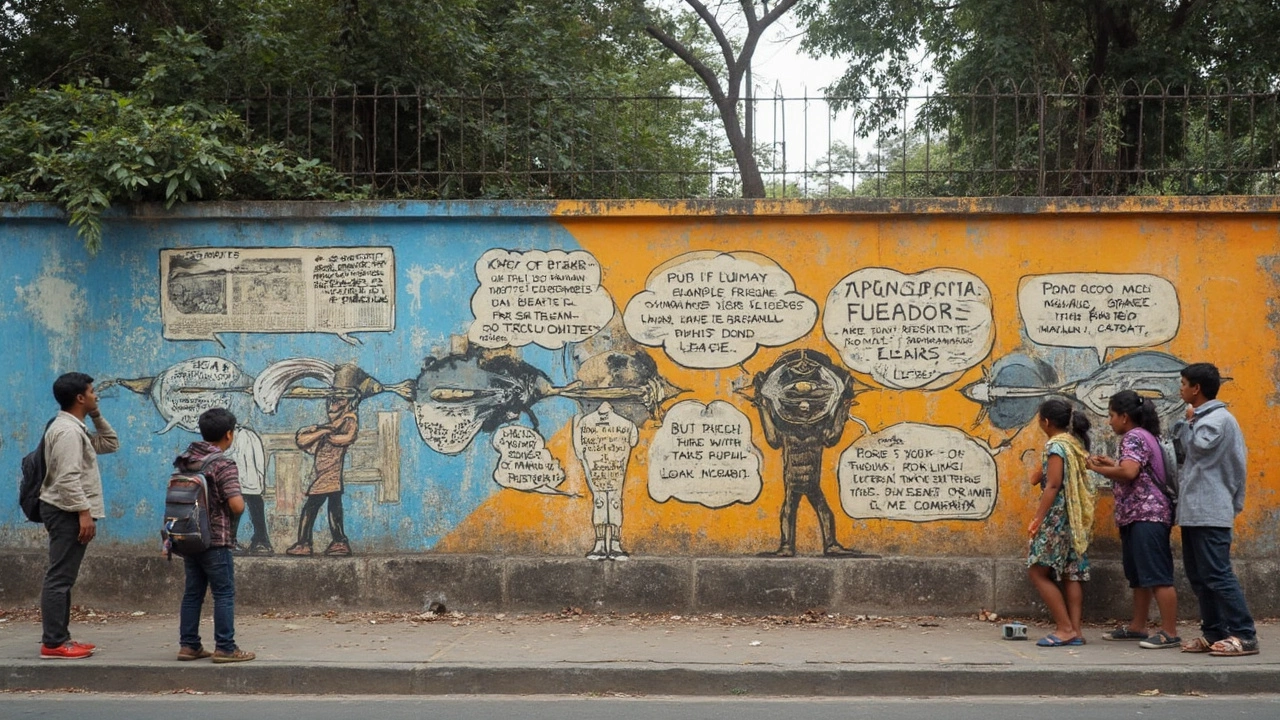If you check out any rugby fixture list, you’ll see Argentina’s team called “Los Pumas.” You might think the name has some epic legend behind it, but it actually started with a simple mistake. Today, though, it’s stuck—and now the whole rugby world knows exactly who you’re talking about when you say it.
But what does “Los Pumas” even mean, and why does it matter? If you’re heading to a match or following Argentina’s games online, you’re probably curious about what sets this team apart (besides that wild puma logo). Getting to know the story behind their nickname not only helps with trivia night, but it also gives you a real feel for the team’s character out on the field.
- The Famous Nickname: Los Pumas
- How the Nickname Started
- Common Misconceptions
- What Makes Los Pumas Unique
- The Nickname’s Impact on the Team
- Tips for Following Argentina Rugby Fixtures
The Famous Nickname: Los Pumas
If you’re into rugby fixtures, you’ve definitely heard talk about Argentina rugby being called Los Pumas. That’s what everyone uses—media, fans, and even rival teams. But here’s a wild fact: Argentina’s national animal isn’t even the puma. Still, the name stuck to the rugby team like glue ever since their first big international tour in 1965.
Before the 1960s, Argentina’s rugby squad didn’t have a big-time nickname. They were just the national team. When they toured South Africa for the first time, a local journalist snapped a photo of the team’s badge, which had a jaguar on it, and called them “The Pumas” in his report. The animal on their badge was actually a yaguareté, which is a kind of jaguar native to South America, not a puma at all. But no one bothered to correct him, and within weeks, the whole rugby scene started calling them that.
The nickname gave the team an identity and a brand. It’s printed on shirts, splashed on stadium banners, and you’ll even see it used in official social media handles.
| Fact | Detail |
|---|---|
| Official Nickname | Los Pumas |
| First International Use | 1965 |
| Original Animal on Badge | Jaguar (Yaguareté) |
| Actual Animal "Puma" Used? | No, but the nickname stayed |
| First Major Tour | South Africa, 1965 |
The next time you see Argentina lined up for the national anthem, remember: the story behind their name is as Argentine as it gets—a bit of mix-up, a lot of spirit, and total commitment.
How the Nickname Started
The story behind the nickname “Los Pumas” is a classic example of a mix-up that just stuck. Back in 1965, the Argentina national rugby team went on a historic tour in South Africa. They played well above expectations. Suddenly, the world started paying attention—especially the local media.
It was on this tour that a South African journalist, Carl Kohler, made an honest mistake. He spotted the animal on the team's badge, which was actually a jaguar, and called it a puma instead. The thing is, pumas don’t even roam wild in Argentina! Yet the nickname sounded catchy and, almost overnight, the world picked it up.
“We called them ‘The Pumas’ and the name was instantly popular, despite the actual animal being a jaguar. The players ran with it, and so did the fans,” wrote Kohler in his match summary for the South African press.
Check out the simple details between the two animals involved in this nickname blunder:
| Animal | Native to Argentina? | Found on Original Badge? |
|---|---|---|
| Puma | No | No |
| Jaguar | Yes | Yes |
It’s kind of funny to think that one of international rugby’s best-known team names grew out of a mix-up. Still, the catchy nickname helped the Argentina rugby team start building its own global identity—way before they were winning big games on the world stage.
Common Misconceptions
You'll run into a lot of myths about the Argentina rugby team’s nickname. The biggest one? Most people assume their mascot has always been a puma because that animal is native and fierce, but the truth is, the actual roots are way less glamorous. When the team toured South Africa in 1965, a local journalist wanted a catchy nickname. He spotted the jaguar on their badge—which looks nothing like a puma—and mistakenly called the team “Los Pumas” in his article. The name just stuck, even though the original badge showed a jaguar, not a puma.
This little error might sound funny now, but it led to a huge identity for the entire squad. So, if you thought the team chose the Argentina rugby nickname to match local wildlife, guess again. They rolled with a journalist’s slip-up and now own it completely.
Another common mix-up is thinking Los Pumas are a brand-new name. In reality, the team has been called Los Pumas for decades. Some even confuse the team with Argentina’s rugby league side, who are known as the “Argentine Jaguars.” Quick tip: Union team = Los Pumas, League team = Jaguars.
When watching a game or following fixtures, just remember this quirky origin story. It’s a cool bit of rugby trivia and helps you spot newcomers who still call them the Jaguars—old habits die hard, even among die-hard fans.

What Makes Los Pumas Unique
Argentina’s rugby squad isn’t just another team fitting into the global rugby scene. If you look closely, Los Pumas bring a totally different vibe—on and off the pitch. They’re not just about the kit or the jaguar-looking logo (which is a whole story by itself). Their style, mentality, and even their fan base make them stand out from the rest.
First off, Los Pumas play with a kind of passion that’s impossible to ignore. Latin American teams are famous for being emotional, but in rugby, Argentina has turned that into a weapon. When they face top teams like New Zealand or South Africa, you can feel the fire—not just in big tackles, but in the way they come back from behind or celebrate the small wins on the field.
Most rugby nations lean on long histories and domestic leagues. Argentina took a different path. They had to scrap for international respect. Their players often had to move to Europe to get pro contracts until 2016, when the Jaguares (Argentina’s team in Super Rugby) were formed and finally gave local players real exposure.
They’re also tactically different. If you’re new to watching Los Pumas, don’t be surprised if scrums and mauls seem like their specialty. Historically, Argentina has produced some of the world’s toughest forwards—guys in the front of the pack who wrestle for control. Physicality is just their thing. But recently, they’ve added sharp counterattacks and skilled backs who can surprise even the All Blacks.
When you look at big moments, Los Pumas have pulled off some shocks nobody expected. Beating France in the 2007 Rugby World Cup opening match got everyone’s attention. Then in 2020, they beat New Zealand for the first time ever—talk about making history.
- A team built on local grit but now with global talent
- Known for strong set-pieces: scrummaging and line-outs
- Fans call them wildly passionate—almost like a football crowd
- Secured their best World Cup finish with third place in 2007
The following table shows some standout moments that define Los Pumas’ journey:
| Year | Event | Result |
|---|---|---|
| 2007 | Rugby World Cup (France) | 3rd place, beat hosts France twice |
| 2015 | Rugby World Cup (England) | 4th place, reached semi-finals |
| 2020 | Tri-Nations (Australia) | Beat New Zealand 25-15, first time ever |
So if you ever wonder why people get hyped about Argentina rugby, it boils down to this: Los Pumas fight like underdogs, but they play like they’ve got nothing to lose—and that makes every game a must-watch.
The Nickname’s Impact on the Team
The moment Argentina’s rugby squad became known as Los Pumas, something clicked for both players and fans. Suddenly, the team wasn’t just the national side—they had a clear identity. The puma logo started popping up on jerseys, banners, and stadium walls. It gave everyone something to rally around and talk about, especially when Argentina played against the giants of world rugby.
The nickname’s impact showed up big in global tournaments. Check out the 2007 Rugby World Cup: Argentina finished third, their best ever. Fans and commentators called them "Los Pumas" in headlines all over the world. The puma became a symbol of the squad’s grit—fast, fearless, always ready for an upset win. Players talked about how they felt part of a legacy, not just a roster spot. Captain Agustín Pichot even said in interviews that the spirit of the nickname pushed them to play harder.
Your average match in Buenos Aires is another good example. Local kids show up in puma face paint. Supporters chant “Vamos Pumas!” before the match even starts. Even the team’s kit sponsors, like Nike and now Umbro, use the puma logo as a selling point for jerseys and merch.
Here’s some quick data on how things changed for Argentina rugby after "Los Pumas" caught on:
| Year | World Ranking | World Cup Placement | Number of Registered Players |
|---|---|---|---|
| 2000 | 10th | Group Stage | ~30,000 |
| 2007 | 6th | 3rd Place | ~45,000 |
| 2015 | 5th | 4th Place | ~65,000 |
The rise in popularity is no mystery. The catchy nickname not only helped with sponsorship deals and fan merch, but also boosted rugby’s profile back home. You see more kids choosing rugby over soccer than ever before, especially in cities like Rosario and Tucumán. TV ratings and ticket sales are up. The nickname made the team a brand, not just a lineup on the schedule.
If you’re new to following Argentina rugby, chanting “Vamos Pumas!” at your screen isn’t just for show. You’re joining a tradition that’s helped shape the team’s attitude—and their results—since the name first stuck.
Tips for Following Argentina Rugby Fixtures
Staying on top of Argentina’s rugby fixtures will make sure you never miss a key match, and there’s more to it than just searching the team’s name. Here’s what works if you want to keep up with Argentina rugby, check live scores, or see which stadiums are hosting the next big games.
- Official Team Channels: Follow Los Pumas’ official website and social media (@lospumasarg on Instagram and Twitter). They drop schedules, line-ups, injury updates, and live commentary before the mainstream rugby coverage picks it up.
- World Rugby and Tournament Pages: Major tours like The Rugby Championship or the Rugby World Cup have match schedules and group tables posted months ahead. You can sign up for email reminders on their official sites.
- Streaming and TV: ESPN and Star+ hold most broadcast rights in South America, but services like FloRugby or RugbyPass have picked up international streaming. Local listings sometimes change—especially for away games—so double-check for kick-off times and coverage.
- Live Scores Apps: Install apps like SofaScore, FlashScore, or the official World Rugby app for real-time scores, stats, and even in-game play-by-play updates. You can set notifications just for Argentina’s matches to avoid distractions.
- Fixture Planning: Big games get announced around December or January for the next calendar year. If you're debating a rugby trip, planning early means cheaper flights and better chances at snagging match tickets before they’re gone.
Curious how the rest of the world keeps track of Argentina’s schedule? Here’s a quick look at their main tournaments and where to spot them:
| Tournament | Typical Months | Coverage |
|---|---|---|
| The Rugby Championship | August–October | ESPN, Star+, World Rugby App |
| Rugby World Cup (every 4 years) | September–October | International networks, Public TV |
| Home Test Matches | June–July | Canal 7 (AR), Star+ |
If you’re hoping to catch an Argentina home fixture in person, Estadio José Amalfitani (Buenos Aires) is their usual base, but major matches might go to cities like Mendoza or Salta. Tickets for big rivals—think against New Zealand or South Africa—sell out fast. Watching live, even on TV, gives you the full rush of a Pumas game: the songs, the drama, the skyrocketing tackles.


